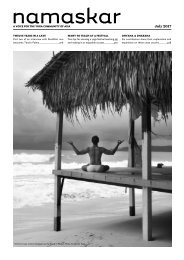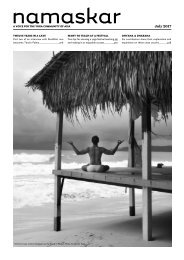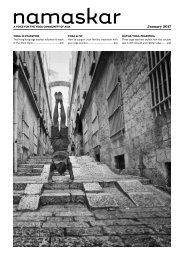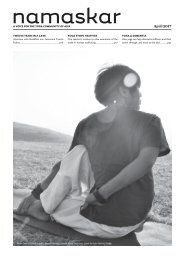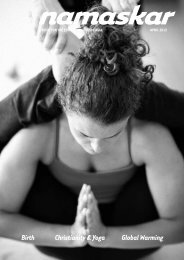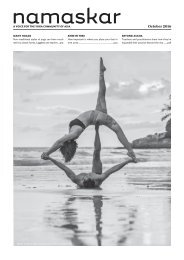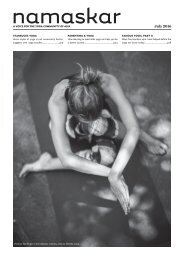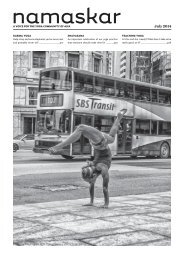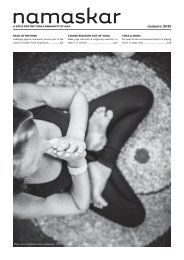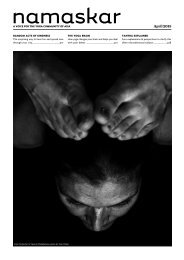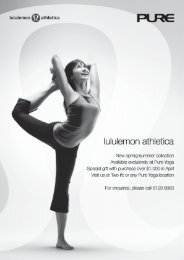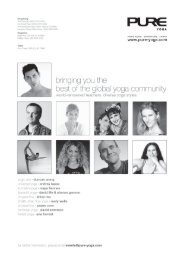Namaskar - Oct 09
You also want an ePaper? Increase the reach of your titles
YUMPU automatically turns print PDFs into web optimized ePapers that Google loves.
Workshop Review<br />
Surf<br />
urfing the Vin<br />
inyas<br />
asa a Wave<br />
Leah Kim<br />
As impressive as Simon Park’s Vrischikasana is on the<br />
advertisement for his workshop (and on our front cover),<br />
there is a noticeable fluidity, grace and ease in his inverted<br />
and backward-bending pose. Similarly, Julia Horn’s yoga and<br />
Tripsichore-inspired performance piece, which starts off their<br />
workshop, is a display of incredible physical talent, and (more<br />
importantly) an expression and offering from her heart.<br />
Their story together began in New York City, where they saw each<br />
other in Dharma Mittra’s class. They soon realised that they are two<br />
peas in a pod. “We’re two very different peas, but we’re definitely in<br />
the same pod,” Julia explains. Perhaps more complementary than<br />
different, the two have a similar essence in their view of yoga and<br />
life, but there is a yin/yang unifying duality about them and their<br />
presence together as teachers.<br />
They share their balanced embodiment of, and approach to, yoga on<br />
their first world tour, teaching in seven countries in seven weeks,<br />
with Hong Kong their first stop. While it is Julia’s first time in<br />
Asia, for Simon it is a return home to his roots. Born in Korea, he<br />
moved to the States at a young age; this is his first trip back to Asia.<br />
the globe. People just seem to understand the language and<br />
movements of vinyasa; it’s inherently universal. It’s a reflection of<br />
today’s fast-paced world. What’s especially powerful about vinyasa is<br />
its accessibility. You can bring in a lot of different elements from<br />
different practices. It’s not about constricting yourself to a label to<br />
say who you are, where you’re from, and whom you belong to. Life<br />
is universal, meaning there is a guiding energy that is beyond<br />
human that informs us all. It’s not about limiting yourself to one<br />
guru. Yes, I have teachers and will love and embody them eternally<br />
in who I am. But evolution is key. Dharma always teaches that God<br />
is right here in the centre of your heart. He is devoted to his guru,<br />
but in his own practice, he creates.”<br />
Julia adds, “the sacred part of the practice is the right brain stuff.<br />
This is where creation happens, and where you connect to the<br />
Collective Consciousness. I believe in the art form of yoga, sacred<br />
lines and geometry of the poses. But anything is and can be yoga,<br />
based on the intention and presence. Having a teacher or learning a<br />
particular style is kind of like being in your family. Your family is<br />
your heritage; you love and respect them and you abide by their<br />
rules, but then you grow up and become a very unique individual. “<br />
Their teaching philosophy is evident in their workshop, “Surfing<br />
Simon still felt his Asian influence growing up, “playing karate”<br />
with his brothers and eventually enrolling in proper karate classes.<br />
Later, wanting to assimilate more to American culture, he moved<br />
towards sports, playing rugby and basketball through college. A<br />
motorcycle accident led him to yoga. “I was at UCLA at the time,<br />
and a friend suggested yoga as a way to rehab my injuries. I looked<br />
at the curriculum and signed up for a class called Yoga for Dancers,<br />
taught by Shiva Rea. It was Shiva’s first class as a yoga teacher at<br />
UCLA and my first yoga experience.” Simon studied with and<br />
assisted Shiva for several years, and considers Shiva and Dharma his<br />
main teachers and influences.<br />
For Julia, “mom did yoga, so as a baby, I was already crawling<br />
around her yoga classes. I started dancing at a young age, so I have<br />
always been in my body. I was blessed with amazing circumstances<br />
growing up. We lived in a small town in the mountains of North<br />
Carolina where I was always running around, jumping off of<br />
things, swinging on ropes into the creek. Acrobatic actions became<br />
second nature to me. I danced in college and worked at a gym,<br />
where I met Dana Flynn of Laughing Lotus. That’s when I realised<br />
dance and yoga are an amazing fusion.”<br />
As far as their teaching style, Simon is hesitant to use labels. “I<br />
don’t want to have a label to my style, but for survival as a yoga<br />
teacher today, it’s kind of a necessity. I think of how Bruce Lee said<br />
to learn from everyone, and then to create your own style.” So<br />
Simon loosely dubs his style Liquid Flow Yoga, which falls within<br />
the general framework of Vinyasa. “I have taught in the States,<br />
Paris, Barcelona, Costa Rica, and now being here in Hong Kong,<br />
what strikes me the most is how similar the styles of yoga are across<br />
34<br />
JULIA & SIMON



